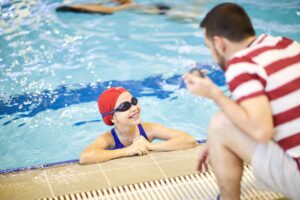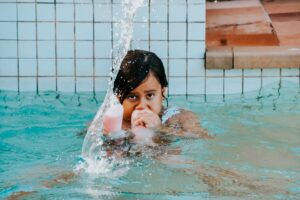
Why is it taking my child longer to learn how to swim properly?
Everyone learns differently. Many factors can affect the pace at which your child learns. Age is a factor that comes into play. At AquaMobile Swim School, 3-5 year-olds take between 20 and 30 lessons to learn how to swim. While 6-9 year-olds take anywhere from eight to twenty lessons. A popular theory suggests learning how to swim requires 10,000 correct repetitions in the pool.
The answer to this question will never be the same for two children. Your little one’s swimming journey is theirs to take and is unique to them.
Here are 5 things that may affect your child’s learning curve in swimming and what you can do to help:
Frequency of lessons and practice sessions
Like with any skill, practice makes perfect for swimmers new to the water. If your child is taking swimming lessons once a week, it is harder for them to reach their full potential.
Solution: Increasing the number of lessons or practice sessions will help your child. When practicing outside of lesson time, make sure that repetitions are correct. For example, the freestyle and breaststroke require two different types of movements. This will refine your child’s skills and prepare them for the next lesson.
Swimming lessons will teach a variety of different skills. Practicing them and making sure that they are done right will help your child get better at swimming and build confidence. Consistency is key because younger children tend to forget what they are taught without repetition.
Motivation (or lack thereof)
Children have different interests and sometimes swimming isn’t one of them. That’s okay, but knowing how to swim could potentially save his or her life. CDC data between 2005 and 2009 reveals 10 people die of drowning every day.
Solution: Making swimming fun is a great way to get kids excited about the pool. Water games and toys make children associate swimming with something positive. There are many ways to make swimming fun!
The pool should be a place for everyone to come together and learn. Swimming lessons teach kids the fundamentals that are needed to have fun in the water. Going for a leisurely swim between lessons makes the difference. Practicing should be made fun. So using games to promote play-based learning might be the push your little one needs to swim like fish!
Past Experiences
Negative memories can hinder your child’s experience in the pool. For example, scraping their knee the last time they went to the pool will make swimming less than enjoyable. Fear of the water can also come into play too. This may result in crying and being upset for half of the lesson. Lessons in turn are not as helpful as they are supposed to be.
Solution: Make the pool a comfortable place. Bringing one of your child’s favourite bathtime toys in the pool can help. A parent or sibling in the pool to be a familiar face can also work well.
One bad memory should not ruin pool playtime forever. The best way to help a child get back into the pool is by helping them associate it with something positive. A toy or family member will reassure little ones. Making new memories can help overshadow the negative ones.
Number of students per class
Class size plays a role in your child’s swimming success. Being in a class that’s too large or too small affects your child’s learning negatively. Private lessons provide students with personalized attention for kids who may be embarrassed learning with their peers around. Other children thrive in a group environment though.
Solution: What works for someone else’s child might not work for yours. If you are unsure, try out both types of lessons. Keep in mind that group lessons should be taught with 2-3 children per instructor.
Small classes and large classes both have their pros and cons. One-on-one and small group lessons help children focus because the instructor can customize lesson plans more. However, some children like a group setting better. This can be due to having friends around to encourage them and socialize with. Finding out what works best for your child can be found out through observing and talking to your child about swimming lessons.
Class Structure
Learning in an environment that’s strict and structured helps some children. While others like learning with fun drills and lenient instruction. This group will not benefit from rigorous lessons and swimming over time. 
Solution: Ask your instructor to try out a new teaching style if your child is progressing at a slower pace. Private and semi-private swimming lessons offer flexibility for children. It also allows instructors to customize classes to cater to the needs and skill levels of individual students.
How one child learns differs from another. Children who like more structure prefer more strict lessons. These types of lessons are good for kids who like to learn at a fast pace. While others like a more relaxed atmosphere that fosters growth over time.

